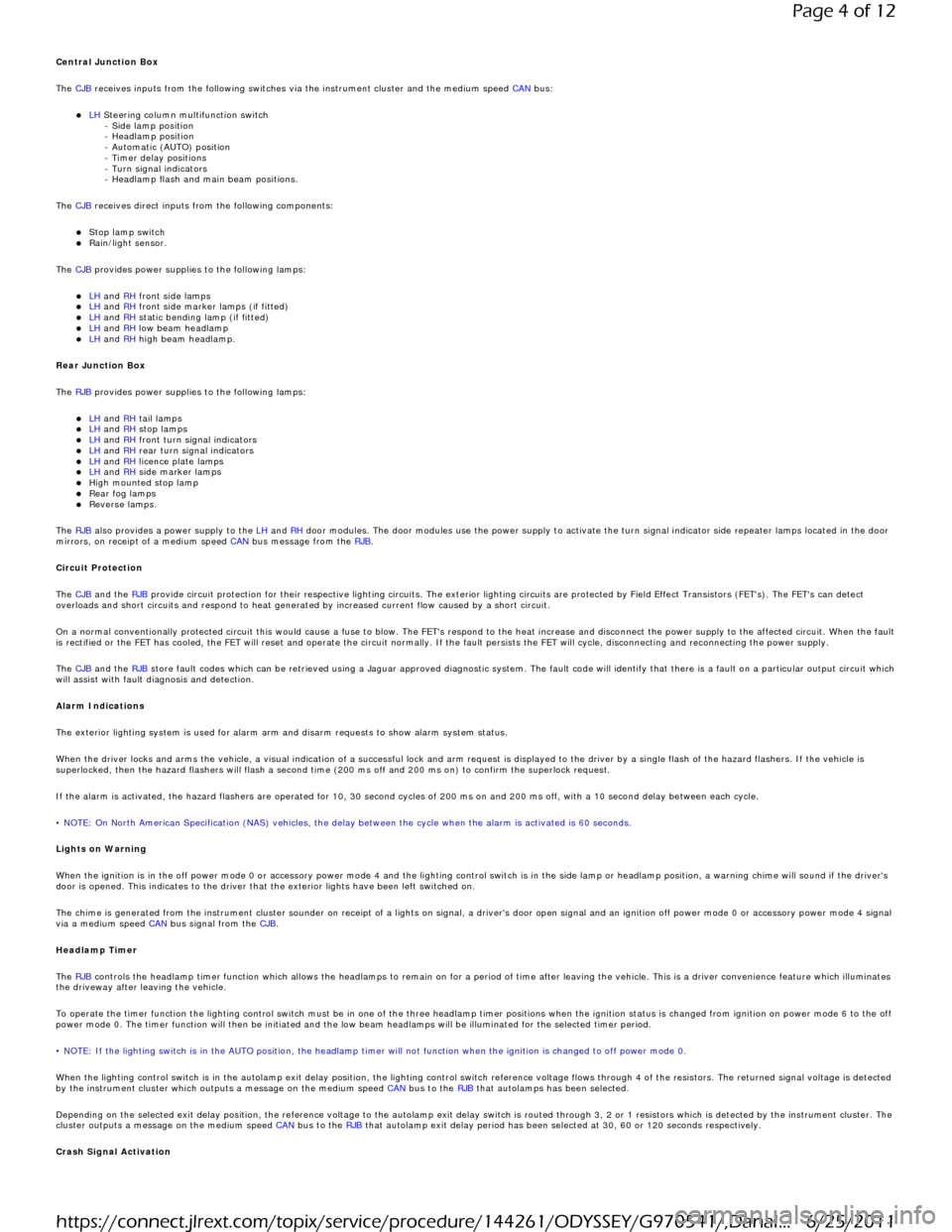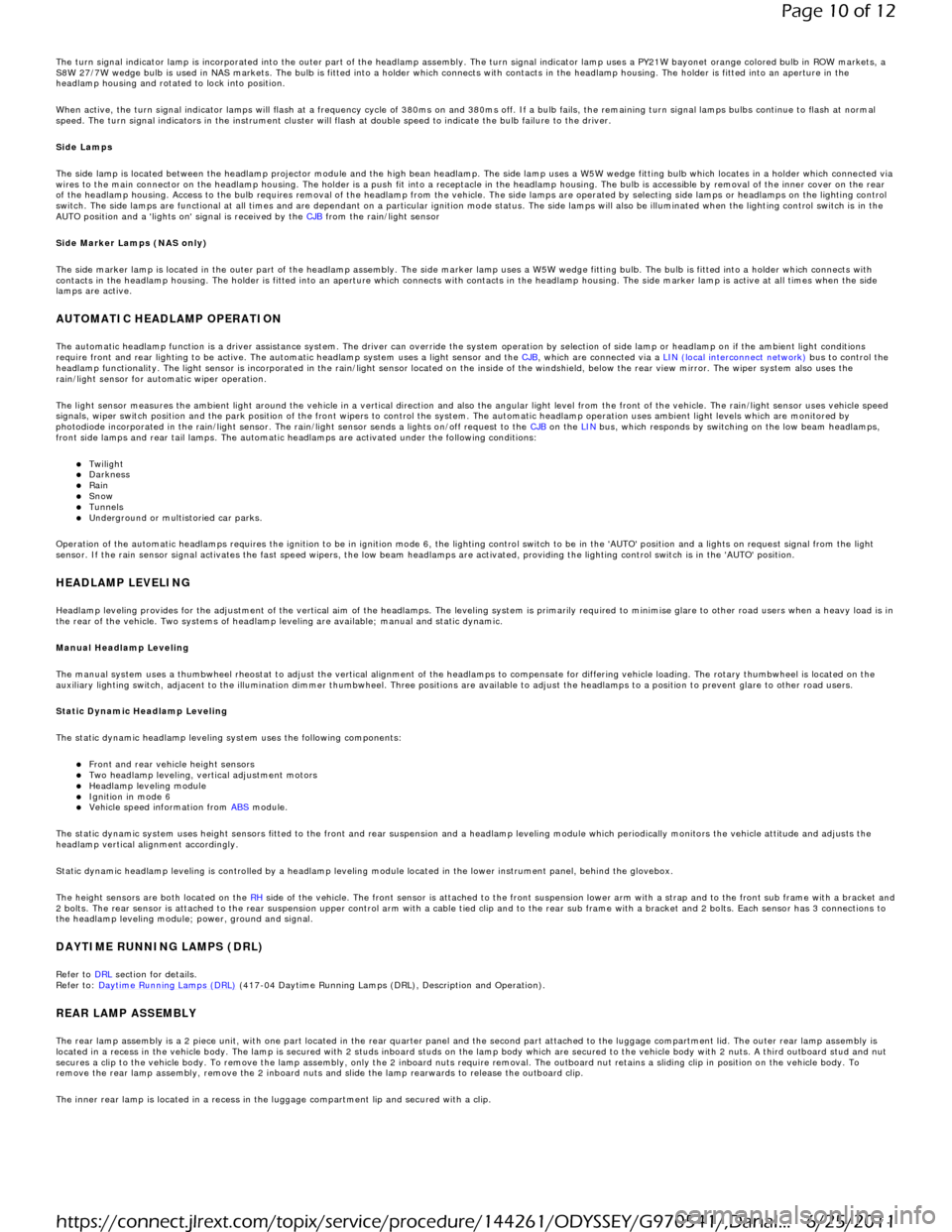ESP JAGUAR XF 2009 1.G Lighting In Detail Manual
[x] Cancel search | Manufacturer: JAGUAR, Model Year: 2009, Model line: XF, Model: JAGUAR XF 2009 1.GPages: 12, PDF Size: 0.86 MB
Page 4 of 12

Central Junction Box
The CJB receives inputs from the following switches via the instrument cluster and the medium speed CAN bus:
LH Steering column multifunction switch
- Side lamp position
- Headlamp position
- Automatic (AUTO) position
- Timer delay positions
- Turn signal indicators
- Headlamp flash and main beam positions.
The CJB receives direct inputs from the following components:
Stop lamp switch Rain/light sensor.
The CJB provides power supplies to the following lamps:
LH and RH front side lamps LH and RH front side marker lamps (if fitted) LH and RH static bending lamp (if fitted) LH and RH low beam headlamp LH and RH high beam headlamp.
Rear Junction Box
The RJB provides power supplies to the following lamps:
LH and RH tail lamps LH and RH stop lamps LH and RH front turn signal indicators LH and RH rear turn signal indicators LH and RH licence plate lamps LH and RH side marker lamps High mounted stop lamp Rear fog lamps Reverse lamps.
The RJB also provides a power supply to the LH and RH door modules. The door modules use the power supply to activate the turn signal indicator side repeater lamps located in the door
mirrors, on receipt of a medium speed CAN bus message from the RJB.
Circuit Protection
The CJB and the RJB provide circuit protection for their respective lighting circuits. The exterior lighting circuits are protected by Field Effect Transistors (FET's). The FET's can detect
overloads and short circuits and respond to heat generated by increased current flow caused by a short circuit.
On a normal conventionally protected circuit this would cause a fuse to blow. The FET's respond to the heat increase and disconnect the power supply to the affected circuit. When the fault
is rectified or the FET has cooled, the FET will reset and operate the circuit normally. If the fault persists the FET will cycle, disconnecting and reconnecting the power supply.
The CJB and the RJB store fault codes which can be retrieved using a Jaguar approved diagnostic system. The fault code will identify that there is a fault on a particular output circuit which
will assist with fault diagnosis and detection.
Alarm Indications
The exterior lighting system is used for alarm arm and disarm requests to show alarm system status.
When the driver locks and arms the vehicle, a visual indication of a successful lock and arm request is displayed to the driver by a single flash of the hazard flashers. If the vehicle is
superlocked, then the hazard flashers will flash a second time (200 ms off and 200 ms on) to confirm the superlock request.
If the alarm is activated, the hazard flashers are operated for 10, 30 second cycles of 200 ms on and 200 ms off, with a 10 second delay between each cycle.
• NOTE: On North American Specification (NAS) vehicles, the delay between the cycle when the alarm is activated is 60 seconds.
Lights on Warning
When the ignition is in the off power mode 0 or accessory power mode 4 and the lighting control switch is in the side lamp or headlamp position, a warning chime will sound if the driver's
door is opened. This indicates to the driver that the exterior lights have been left switched on.
The chime is generated from the instrument cluster sounder on receipt of a lights on signal, a driver's door open signal and an ignition off power mode 0 or accessory power mode 4 signal
via a medium speed CAN bus signal from the CJB.
Headlamp Timer
The RJB controls the headlamp timer function which allows the headlamps to remain on for a period of time after leaving the vehicle. This is a driver convenience feature which illuminates
the driveway after leaving the vehicle.
To operate the timer function the lighting control switch must be in one of the three headlamp timer positions when the ignition status is changed from ignition on power mode 6 to the off
power mode 0. The timer function will then be initiated and the low beam headlamps will be illuminated for the selected timer period.
• NOTE: If the lighting switch is in the AUTO position, the headlamp timer will not function when the ignition is changed to off power mode 0.
When the lighting control switch is in the autolamp exit delay position, the lighting control switch reference voltage flows through 4 of the resistors. The returned signal voltage is detected
by the instrument cluster which outputs a message on the medium speed CAN bus to the RJB that autolamps has been selected.
Depending on the selected exit delay position, the reference voltage to the autolamp exit delay switch is routed through 3, 2 or 1 resistors which is detected by the instrument cluster. The
cluster outputs a message on the medium speed CAN bus to the RJB that autolamp exit delay period has been selected at 30, 60 or 120 seconds respectively.
Crash Signal Activation
Page 4 of 12
6/25/2011 https://connect.jlrext.com/topix/service/procedure/144261/ODYSSEY/G970541/,DanaI...
Page 10 of 12

The turn signal indicator lamp is incorporated into the outer part of the headlamp assembly. The turn signal indicator lamp uses a PY21W bayonet orange colored bulb in ROW markets, a
S8W 27/7W wedge bulb is used in NAS markets. The bulb is fitted into a holder which connects with contacts in the headlamp housing. The holder is fitted into an aperture in the
headlamp housing and rotated to lock into position.
When active, the turn signal indicator lamps will flash at a frequency cycle of 380ms on and 380ms off. If a bulb fails, the remaining turn signal lamps bulbs continue to flash at normal
speed. The turn signal indicators in the instrument cluster will flash at double speed to indicate the bulb failure to the driver.
Side Lamps
The side lamp is located between the headlamp projector module and the high bean headlamp. The side lamp uses a W5W wedge fitting bulb which locates in a holder which connected via
wires to the main connector on the headlamp housing. The holder is a push fit into a receptacle in the headlamp housing. The bulb is accessible by removal of the inner cover on the rear
of the headlamp housing. Access to the bulb requires removal of the headlamp from the vehicle. The side lamps are operated by selecting side lamps or headlamps on the lighting control
switch. The side lamps are functional at all times and are dependant on a particular ignition mode status. The side lamps will also be illuminated when the lighting control switch is in the
AUTO position and a 'lights on' signal is received by the CJB from the rain/light sensor
Side Marker Lamps (NAS only)
The side marker lamp is located in the outer part of the headlamp assembly. The side marker lamp uses a W5W wedge fitting bulb. The bulb is fitted into a holder which connects with
contacts in the headlamp housing. The holder is fitted into an aperture which connects with contacts in the headlamp housing. The side marker lamp is active at all times when the side
lamps are active.
AUTOMATIC HEADLAMP OPERATION
The automatic headlamp function is a driver assistance system. The driver can override the system operation by selection of side lamp or headlamp on if the ambient light conditions
require front and rear lighting to be active. The automatic headlamp system uses a light sensor and the CJB, which are connected via a LIN (local interconnect network) bus to control the
headlamp functionality. The light sensor is incorporated in the rain/light sensor located on the inside of the windshield, below the rear view mirror. The wiper system also uses the
rain/light sensor for automatic wiper operation.
The light sensor measures the ambient light around the vehicle in a vertical direction and also the angular light level from the front of the vehicle. The rain/light sensor uses vehicle speed
signals, wiper switch position and the park position of the front wipers to control the system. The automatic headlamp operation uses ambient light levels which are monitored by
photodiode incorporated in the rain/light sensor. The rain/light sensor sends a lights on/off request to the CJB on the LIN bus, which responds by switching on the low beam headlamps,
front side lamps and rear tail lamps. The automatic headlamps are activated under the following conditions:
Twilight Darkness Rain Snow Tunnels Underground or multistoried car parks.
Operation of the automatic headlamps requires the ignition to be in ignition mode 6, the lighting control switch to be in the 'AUTO' position and a lights on request signal from the light
sensor. If the rain sensor signal activates the fast speed wipers, the low beam headlamps are activated, providing the lighting control switch is in the 'AUTO' position.
HEADLAMP LEVELING
Headlamp leveling provides for the adjustment of the vertical aim of the headlamps. The leveling system is primarily required to minimise glare to other road users when a heavy load is in
the rear of the vehicle. Two systems of headlamp leveling are available; manual and static dynamic.
Manual Headlamp Leveling
The manual system uses a thumbwheel rheostat to adjust the vertical alignment of the headlamps to compensate for differing vehicle loading. The rotary thumbwheel is located on the
auxiliary lighting switch, adjacent to the illumination dimmer thumbwheel. Three positions are available to adjust the headlamps to a position to prevent glare to other road users.
Static Dynamic Headlamp Leveling
The static dynamic headlamp leveling system uses the following components:
Front and rear vehicle height sensors Two headlamp leveling, vertical adjustment motors Headlamp leveling module Ignition in mode 6 Vehicle speed information from ABS module.
The static dynamic system uses height sensors fitted to the front and rear suspension and a headlamp leveling module which periodically monitors the vehicle attitude and adjusts the
headlamp vertical alignment accordingly.
Static dynamic headlamp leveling is controlled by a headlamp leveling module located in the lower instrument panel, behind the glovebox.
The height sensors are both located on the RH side of the vehicle. The front sensor is attached to the front suspension lower arm with a strap and to the front sub frame with a bracket and
2 bolts. The rear sensor is attached to the rear suspension upper control arm with a cable tied clip and to the rear sub frame with a bracket and 2 bolts. Each sensor has 3 connections to
the headlamp leveling module; power, ground and signal.
DAYTIME RUNNING LAMPS (DRL)
Refer to DRL section for details.
Refer to: Daytime Running Lamps (DRL) (417-04 Daytime Running Lamps (DRL), Description and Operation).
REAR LAMP ASSEMBLY
The rear lamp assembly is a 2 piece unit, with one part located in the rear quarter panel and the second part attached to the luggage compartment lid. The outer rear lamp assembly is
located in a recess in the vehicle body. The lamp is secured with 2 studs inboard studs on the lamp body which are secured to the vehicle body with 2 nuts. A third outboard stud and nut
secures a clip to the vehicle body. To remove the lamp assembly, only the 2 inboard nuts require removal. The outboard nut retains a sliding clip in position on the vehicle body. To
remove the rear lamp assembly, remove the 2 inboard nuts and slide the lamp rearwards to release the outboard clip.
The inner rear lamp is located in a recess in the luggage compartment lip and secured with a clip.
Page 10 of 12
6/25/2011 https://connect.jlrext.com/topix/service/procedure/144261/ODYSSEY/G970541/,DanaI...